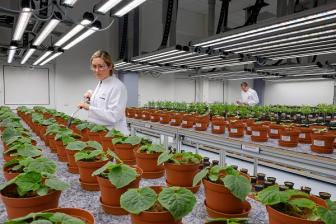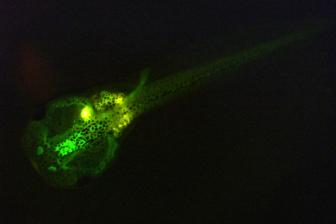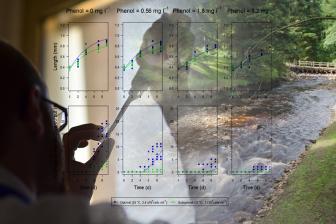- Your Product Type
- Your Study Type
- Aquatic Ecotoxicology
- Aquatic Invertebrates
- OECD 202: Daphnia sp., Acute Immobilisation Test
- OECD 211: Daphnia magna Reproduction Test
- OECD 235: Chironomus sp., Acute Immobilisation Test
- OECD 218/219: Sediment-Water Chironomid Toxicity Test Using Spiked Sediment/Spiked Water
- OECD 233: Sediment-Water Chironomid Life-Cycle Toxicity Test Using Spiked Water or Spiked Sediment
- OECD 225: Sediment-water Lumbriculus Toxicity Test Using Spiked Sediment
- OECD 242: Potamopyrgus antipodarum Reproduction Test
- OECD 243: Lymnaea stagnalis Reproduction Test
- Fish and other vertebrates
- OECD 203: Fish, Acute Toxicity Test
- OECD 215: Fish Juvenile Growth Study
- OECD 212: Fish, Short-term Toxicity Test on Embryo and Sac-fry Stages
- OECD 231: The Amphibian Metamorphosis Assay
- OECD 236: Fish Embryo Acute Toxicity Test
- OECD 210: Fish, Early-life Stage Toxicity Test
- OECD 229 Fish Short Term Reproduction Assay and OECD 230 21-day Fish Assay
- OECD 240 Medaka Extended One Generation Reproduction Test (MEOGRT)
- OECD 248: Xenopus Eleutheroembryonic Thyroid Assay
- OPPTS 850.1500: Fish Life Cycle Toxicity Test
- OÈCD 234 Fish sexual development test
- Aquatic plants
- Analytical Dose Verification
- Aquatic Invertebrates
- Chemistry
- Biodegradation Studies
- Analytical Chemistry Studies and Residues
- Physical-Chemical Properties Studies
- Storage Stability Studies
- OPPTS 830.6302, OPPTS 830.6303,and OPPTS 830.6304: Physical State, Colour and Odor at 20 °C and at 101.3 kPa
- EU A.1: Melting temperature/range
- EU A.2: Boiling temperature
- EU A.3: Relative density (liquids and solids)
- EU A.4: Vapour pressure
- EU A.5: Surface tension
- EU A.9: Flashpoint
- EU A.10: Flammability (solids)
- EU A.12: Flammability (contact with water)
- EU A.13: Pyrophoric properties of solids and liquids
- EU A.16: Relative self-ignition temperature for solids
- EU A.17: Oxidising properties
- OECD 114: Viscosity of Liquids
- Environmental Fate
- Transformation in Soil
- Transformation in Water
- Transformation in Manure
- Adsorption on Soil and Sewage Sludge
- Bioaccumulation and Bioconcentration
- Terrestrial Ecotoxicology
- Non-target Arthropods
- Non-target arthropod testing with the parasitic wasp (Aphidius rhopalosiphi)
- Non-target arthropod testing with the lacewing (Chrysoperla carnea)
- Non-target arthropod testing with the ladybird beetle (Coccinella septempunctata)
- Non-target arthropod testing with the predatory bug (Orius laevigatus)
- Non-target arthropod testing with the predatory mite (Typhlodromus pyri)
- Non-target arthropod testing with the rove beetle (Aleochara bilineata)
- Non-target arthropod testing with the carabid beetle (Poecilus cupreus)
- Non-target arthropod testing with the wolf spider (Pardosa spec.)
- Soil Organisms
- Honey Bees and other Pollinators
- OECD 213/214: Honey bees, Acute Oral and Acute Contact Toxicity Test
- OECD 245: Honey Bee (Apis Mellifera L.), Chronic Oral Toxicity Test (10-Day Feeding)
- OECD 237: Honey Bee Larval Toxicity Test, Single Exposure
- OECD 239: Honey Bee Larval Toxicity Test
- EPPO 170: Honey Bee Field Study – do plant protection products effect honey bee colonies?
- Oomen et al. 1992: Honey Bee Brood Feeding Study
- OECD 75: Honey Bee Brood Test under Semi-field Conditions in Tunnels
- OECD 246/247 Acute Oral and Contact Toxicity to the Bumblebee, Bombus terrestris L.
- Solitary Bee Acute Contact Toxicity Study in the Laboratory (Osmia sp.) Solitary Bee Acute Oral Toxicity Study in the Laboratory (Osmia sp.) (protocols for ringtests with solitary bees recommended by the non-Apis working group)
- SANTE/11956/2016 rev.9 Residue trials for MRL setting in honey
- Non-target plants
- OECD 208: Terrestrial Plant Test - Seedling Emergence and Seedling Growth Test
- OECD 227: Terrestrial Plant Test - Vegetative Vigour Test
- OCSPP 850.4100: Seedling Emergence and Seedling Growth
- OCSPP 850.4150: Vegetative Vigor
- EPPO PP 1/207(2): Efficacy evaluation of plant protection products, Effects on succeeding crops
- Field Studies
- Non-target Arthropods
- Ecological Modelling
- Quality Assurance
- Testing of Potential Endocrine Disruptors
- Aquatic Ecotoxicology
- News
- Company
- Career
- Contact
Current Insights
ibacon’s bespoke facilities enable year-round environmental risk assessment of Non-Target Terrestrial Plants
28th October 2020
Carrying out environmental risk assessment testing on outdoor Non-Target Terrestrial Plants (NTTP) is something that is dependent on the season. In many regions around the world the testing of NTTP is restricted to the growing season.
How the XETA test is transforming testing for endocrine disruption
22nd October 2020
By Maria Meinerling, Head Of Scientific and Technological Innovation, Vice Head of Test Facility - Assessing and testing chemicals for their endocrine potential is scientifically demanding and requires both specific expertise and hig
Modelling approaches can be a valuable addition to market authorization dossiers
21st October 2020
By Benoit Goussen, Section Head Ecological Modelling - Combining modelling methods with more traditional experimental methods can deliver important supplementary data wh
State-of-the art laboratories offer excellent techniques in assessing environmental fate
15th October 2020
By Patrick Riefer, Section Head Environmental Fate - Recent lab investments at ibacon now enable us to carry out a broad spectrum of environmental fate laboratory studies.
Xenopus Embryonic Thyroid Assay in co-operation with Laboratoire Watchfrog
31st July 2019 - 31st December 2019
Amphibian metamorphosis is controlled by thyroid hormones and is associated with TH/bZIP gene expression. This process can be made visible through use of the "Green Fluorescent Protein" (GFP); exhibiting bright green fluorescence under TH/bZIP gene expression.
New archive room
1st December 2016 - 31st December 2016
2016 is a successfull year. A huge amount of studies has already been finalised and the studies as well as the relating data need to be securely stored according to GLP regulations.
Gyceria maxima ring test
The risk assessment portfolio for aquatic plants still lacks a test that can be conducted for rooted monocotyledonous plants. In cases where
Bumble bee semi-field study - ibacon establishes new study design
17th December 2015
The global decline of pollinators (honey bees, bumble bees, solitary bees) has been a research topic for the last couple of years, as these insects play a pivotal role in crop and food production as well as for maintenance of plant biodiversity.
Scientists discuss several factors involved in this decline, among them habitat loss, diseases, parasites, beekeeping techniques, and for agricultural areas plant protection products. Especially plant protection products have received considerable public attention and regulatory agencies all over the world have indroduced new testing requirements for the environmental risk assessment of these substances.
For bumble bees (Bombus spp.) there have been only few guidelines available so far. To fill this gap, ibacon is currently developing testing designs and GLP-protocols for several additional bumble bee studies.
One of these study designs is the “Bumble bee study in tunnels under semi-field conditions”. The protocol was adapted from the existing protocols for honey bee semi-field and field studies. Our intention was to develop suitable methodologies and to define appropriate endpoints for statistical evaluation.




